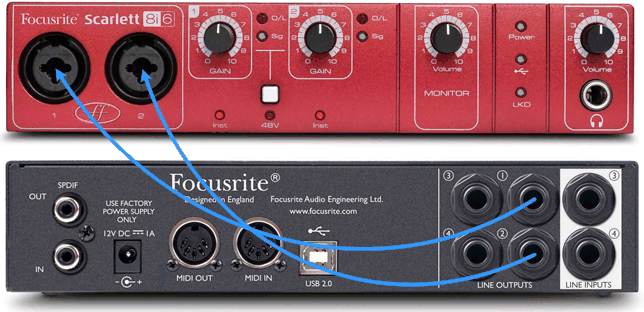 |
| A loop-back test patches the output of a sound card or external converter back to its own input, to assess the degradation from one or more recording passes. |
| www.ethanwiner.com - since 1997 |
Converter Loop-Back Tests
Read all about
Ethan's |
Since the 1990s digital audio converters and sound cards have improved enormously, and even budget models these days are clean enough to capture and reproduce music accurately. Yet some people still believe you must spend thousands of dollars per channel to get a converter whose degradation is not noticeable. Some will tell you that even the finest converters available at any price are not fully transparent.
To make the degradation of high quality converters easier to hear, it's common to record several "generation" passes, so the distortion and other errors accumulate more than after a single recording. A common method plays music from a Wave file through a converter's output, then connects the converter's output back to its own input to be recorded again. This is called a loop-back test, because the output is "looped" back into the input as shown in the figure below. If you do this several times in a row, each time playing the last recording as the new source, distortion and frequency response errors will eventually accumulate enough to be audible.
 |
| A loop-back test patches the output of a sound card or external converter back to its own input, to assess the degradation from one or more recording passes. |
In 2006 I did such a test using a $25 SoundBlaster X-Fi sound card. I never wrote an article with files for people to download and identify which file is which, but I posted the files in forums many times to let people assess the quality loss. If you're curious, below are links to an original Wave file, a single copy, plus copies after 5, 10, and 20 generations. To save server space I didn't post all the in-between files, but I still have them in case anyone wants to visit me in person to verify the test method! As you listen to these files you can hear how the clarity degrades slightly, especially after the 10th and 20th generations. Note that it's very difficult to calibrate a sound card for precisely unity gain, so all of the files linked on this page vary in volume very slightly. However, most differ by less than half a dB within each group.
SoundBlaster X-Fi sound card recording an excerpt from
my pop tune Men At Work (each file is about 2 MB):
Original
After 1 Generation
After 5 Generations
After 10 Generations
After 20 Generations
Recently a professional mastering engineer posted in an audio forum that he can hear the degradation from even one generation using the finest converters money can buy. Another forum member said he also was sure he could hear the degradation after one or two generations. I had read an account of a test where, even after ten generations, a roomful of professional recording engineers was unable to reliably identify the quality loss with very high quality converters. So this seemed like the perfect time to repeat this test using a more modern (but not overly expensive) converter. I had recently bought a Focusrite Scarlett 8i6, which is a modern mid-level ($250) USB sound card with four inputs and outputs. I did a loop-back test with two musical excerpts and posted links to the original file plus 1, 5, and 10 copy generations in the same audio forum, and asked people to identify which file was which.
Sadly, both of the people who insisted they could hear the quality loss refused to post their choices, even after I literally begged them to do so. I guess this is not surprising, because it's easy to make such a claim, but quite another thing to back it up! However, a few others did post. One got all the file identities correct, but another was totally wrong - he identified the original as sounding the most degraded!
To reach a wider audience and obtain more data I created three new sets of files, and all are linked below. Your challenge is to identify which file in each group is the original, and which are the various copies. Again, the files are the originals, after 1 copy generation, after 5 generations, and after 10 generations. All of these recordings and files are 16 bits. Had they been recorded at 24 bits there would be even less degradation from each pass.
Email me your choices for the files in all three groups from my Home Page and I'll send you the correct identities. Please do not send your choices by PM through Facebook or YouTube. I need replies by email to organize them efficiently. And please do not share the answers with anyone else because I'll keep this article active and continue to accumulate answers. Eventually I'll have enough to be statistically significant. Note that all of the files below were trimmed slightly to random lengths to prevent that from giving a clue.
Group 1 - Excerpts from a gentle string orchestra plus a
synthesizer-based pop tune (each file is about 5 MB):
File A
File B
File C
File D
Group 2 - Excerpt from the Victor Herbert Cello Concerto (each file
is about 7 MB):
File A
File B
File C
File D
Group 3 - Excerpt from a jazz trio (each file is about 4 MB):
File A
File B
File C
File D
Ethan Winer has been an audio pro and skeptic for most of his adult life. He now heads up RealTraps, where he designs acoustic treatment products for recording studios and home listening rooms.
Entire contents of this web site Copyright © 1997- by Ethan Winer. All rights reserved.